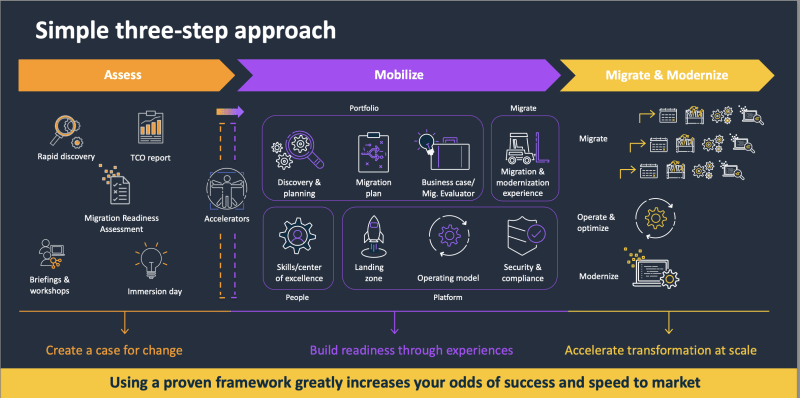Cloud migration is the process of moving data, applications, or other business elements from an on-premise environment to a cloud-based environment. Migrating to Amazon Web Services (AWS) is a popular choice for organizations looking to take advantage of the benefits of cloud computing.
Phases of Cloud Migration
Assessment:
In this phase, organizations conduct a thorough assessment of their existing on-premise infrastructure and identify the elements that need to be migrated to AWS. The assessment also helps organizations determine the best migration strategy and identify any potential roadblocks.
Famous Tools:
Migration Portfolio Assessment is a tool that automates the analysis and validation of a portfolio for cloud migration. It features flexible import workflows and customizable data validation rules for managing portfolio data. It allows users to estimate AWS usage costs, prioritize applications, compare AWS and on-premises costs, and create application groups. It also generates a wave plan for application groups and recommends migration strategies. The tool provides customizable charts for visualizing portfolio data, and users can collaborate with other MPA users and download reports in printable formats.
AWS Migration Evaluator is a powerful tool that provides predictive analytics to inform right-size and right-cost compute, making it easier to build a business case for cloud migration. It analyzes all aspects of an organization’s compute footprint and projects the costs of migration, broken down by infrastructure and software licenses. This helps identify the best migration patterns to achieve business objectives and establish a business case using expert recommendations. Assessments with Migration Evaluator have a track record of reducing costs by up to 50%.
The AWS Optimization and Licensing Assessment (AWS OLA) is a free program that helps both new and existing customers evaluate options for migrating to the cloud or reducing licensing costs. It assesses and optimizes current on-premises and cloud environments based on actual resource utilization, third-party licensing, and application dependencies. By signing up for AWS OLA, you can receive a report that models deployment options using existing licensing entitlements, allowing you to explore cost savings across flexible licensing options. AWS OLA can also be used in conjunction with MAP for Windows, providing you with additional tools, support, and resources to help with your cloud migration and licensing strategy.
Mobilize:
In this phase, organizations prepare for migration by building a migration plan, testing their applications, and setting up their AWS environment. This includes selecting the appropriate AWS services, such as Amazon EC2, Amazon RDS, or Amazon S3, and configuring security, network, and storage.
Famous Tools:
AWS Migration Hub is the ultimate dashboard for tracking your migration progress to the cloud. It lets you audit your existing servers, plan your project, and follow the status of each migration, all in one place. You can arrange existing resources into groups to make following your migration to AWS easier, and oversee the progress of any and all migration tools. AWS partners and some third-party tools can also be tracked in the same interface. The best part is that there’s no additional charge to use Migration Hub. With AWS Migration Hub, you get an all-encompassing, centralized tool that accelerates your migration and modernization readiness.
Migrate:
In this phase, organizations move their data, applications, and other elements from their on-premise environment to AWS. This may involve lifting and shifting existing applications to AWS or re-architecting them for cloud-native deployment.
Advantages of Cloud Migration
Cost Savings: Cloud computing provides organizations with the ability to pay only for the resources they use, reducing capital expenditures and operating expenses.
Scalability: AWS provides organizations with the ability to quickly and easily scale their resources up or down, as needed, without having to purchase and maintain additional hardware.
Increased Agility: Cloud migration allows organizations to rapidly provision new resources and respond to changing business needs.
Improved Security: AWS provides a highly secure cloud environment with multiple layers of security and compliance controls.
Disadvantages of Cloud Migration
Initial Costs: While cloud migration can result in long-term cost savings, organizations may face upfront costs associated with the migration process.
Technical Complexity: Migrating to AWS can be complex and requires a deep understanding of cloud computing and AWS services.
Change Management: Cloud migration can also require organizations to change their existing processes, systems, and culture to fully realize the benefits of cloud computing.
Future Growth and Calculation
According to research, the global cloud computing market is expected to grow at a compound annual growth rate of 17% from 2020 to 2027, reaching a market size of $740 billion by 2027. By migrating to AWS, organizations can tap into this growth and benefit from the latest advancements in cloud computing.
Do's and Don'ts of Cloud Migration
Do's
- Conduct a thorough assessment of your existing on-premise environment.
- Choose the right AWS services for your migration.
- Work with experienced AWS partners to ensure a smooth migration process.
- Plan for a phased approach to migration to minimize risk and ensure business continuity.
Don'ts
- Rush the migration process without proper planning and preparation.
- Neglect to consider the impact of migration on your existing systems and processes.
- Underestimate the technical complexity of cloud migration.
- Forget to regularly monitor and optimize your AWS environment after migration.
General Considerations
Application Compatibility: Organizations should ensure that their existing applications are compatible with AWS services before migrating.
Network Connectivity: Organizations should evaluate their network connectivity requirements and ensure that they have the necessary connectivity to support their migration to AWS.
Data Management: Organizations should carefully plan their data management strategy and ensure that their data is securely and efficiently transferred to AWS.
Security and Compliance: Organizations should consider their security and compliance
AWS Programs for Large-Scale Migrations on AWS
MAP
The AWS Migration Acceleration Program (MAP) is a strategy designed to help organizations migrate to AWS with maximum effectiveness and minimum hassle. It provides a comprehensive, proven methodology for large-scale migration ambitions, with resources including a readiness assessment, a migration plan, and execution support.
The MAP practice consists of three phases: an evaluation of processes to determine an organization’s baseline capabilities, a systematic readiness and preparation effort to create a migration plan, and support to effectively execute the migration plan.
During the Migration Readiness Assessment phase, the AWS Cloud Adoption Framework is used to measure an organization’s current ability to migrate across key areas. The Migration Readiness and Planning Phase involves developing a robust migration plan and calculating the total cost of ownership and potential ROI. The final Migration Phase involves executing the plan with help from the migration partner, typically taking 12-24 months.
Conclusion
Cloud migration can bring many benefits to organizations, including cost savings, scalability, improved performance, and increased flexibility. However, organizations must carefully assess their needs and requirements before migrating to the cloud. By following a structured migration process and considering the advantages and disadvantages of cloud migration, organizations can ensure that their cloud migration is a success.
In conclusion, cloud migration is a critical step for organizations looking to improve their IT infrastructure and stay competitive in today’s fast-paced business environment. With the right approach and the right cloud provider, organizations can reap the benefits of cloud computing and achieve their business goals








Latest comments (1)
Hi.. Nice article.
What is the role of Migration Evaluator and Migration Portfolio Assessment?
Is AWS migraiton Hub takes input from both Migration Evaluator and Migration Portolio Assessment?
Do we need use both of them in a migration?
Thanks in advance.